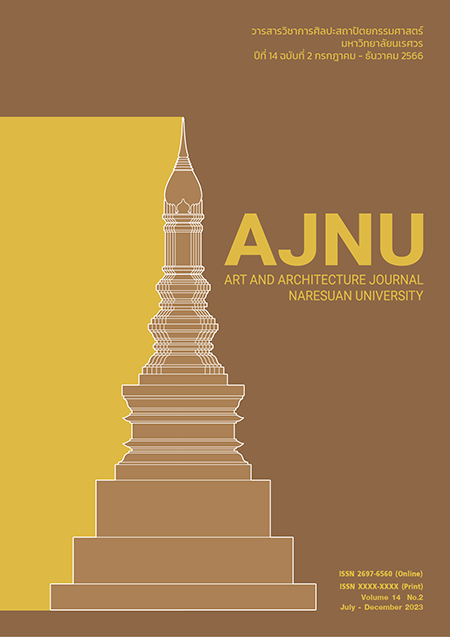The study of properties of thermal insulators of local materials in basketry and weaving in Nakhon Ratchasima province
Main Article Content
Abstract
This research aims to study the thermal properties and heat resistance of local materials in the basketry and weaving type. To develop a solution to prevent heat in buildings with effective alternative materials. The materials studied were woven and sheet textiles. There are both hard and thin sheets. The materials used in the experiment have raw materials or production sources in Nakhon Ratchasima Province. To add a form of utilization to existing products. Four types of materials were studied: silk, reed mats, bamboo basketry. and rattan basketry. By testing with a 60x60x60 centimeters test box, measure the air temperature inside and outside the test box, material surface temperature. Temperature was recorded for 48 hours. To study the guidelines for using local materials for heat protection and decoration in buildings including studies and comparisons on the use.The results of the study concluded that woven bamboo panels have the most heat protection properties, followed by woven rattan panels, reed mats, where silk has the least heat protection properties. In the process of bringing materials for heat protection and decoration of buildings. Using silk or reed mats can be simple and easy. The woven bamboo panels and woven rattan panels are more difficult to cut and install. In terms of material prices, it was found that woven rattan panels had the highest average price per square meter. The woven bamboo panels are the cheapest. If considering the properties of heat protection ease of installation usability and price can be concluded that Woven bamboo panels are the most cost-effective for heat protection and building decoration. Results from the study in this research. It can be extended to study the thermal properties by experimenting in an open box. Experimenting with composites and other coatings or studying various applications. This will increase the value and utilization of local materials more.
Article Details

This work is licensed under a Creative Commons Attribution-NonCommercial-NoDerivatives 4.0 International License.
References
กระทรวงพลังงาน. (2552). หลักเกณฑ์และวิธีการคำนวณในการออกแบบอาคารแต่ละระบบ การใช้พลังงานโดยรวมของอาคาร และการใช้พลังงานหมุนเวียนในระบบต่าง ๆ ของอาคาร พ.ศ. 2552. ประกาศกระทรวงพลังงาน. ออกตามความในพระราชบัญญัติการส่งเสริมการอนุรักษ์พลังงาน พ.ศ. 2535.
ฉันทมน โพธิพิทักษ์. (2560). การออกแบบอาคารเพื่อการประหยัดพลังงาน. (พิมพ์ครั้งที่ 1). กรุงเทพมหานคร: มหาวิทยาลัยเทคโนโลยีราชมงคลรัตนโกสินทร์.
ชญาณิน จิตรานุเคราะห์. (2550). การวิเคราะห์สาระสำคัญของเทคโนโลยีเรือนไทยภาคกลาง (สถ.ด). กรุงเทพมหานคร:จุฬาลงกรณ์มหาวิทยาลัย.
ณรัฐ ข้องม่วง และ อรรจน์ เศรษฐบุตร. (2559). ประสิทธิภาพการป้องกันความร้อนผ่านหลังคาเมทัลชีท โดยการใช้สีเทอร์โมโครมิก. การประชุมวิชาการเทคโนโลยีอาคารด้านพลังงานและสิ่งแวดล้อม ครั้งที่ 3. ขอนแก่น: คณะสถาปัตยกรรมศาสตร์ มหาวิทยาลัยขอนแก่น.
ธงชัย หมั่นเพียรกิจ. (2554). ประสิทธิภาพทางความร้อนของผนังไม้ไผ่ในบ้านเขตร้อนชื้น. (สถ.ม). กรุงเทพมหานคร: จุฬาลงกรณ์มหาวิทยาลัย.
พัชรพล เวียรศิลป์. (2555). การศึกษาอุณหภูมิและความชื้นสัมพัทธ์ในอาคารโดยกล่องทดลอง. (สถ.ม). ขอนแก่น:มหาวิทยาลัยขอนแก่น.
ฤทธิชัย ศรีจวน และ ชูพงษ์ ทองคำสมุทร. (2559). การปรับปรุงฉนวนผนังยุ้งข้าวเพื่อลดการถ่ายเทความร้อน โดยการใช้วัสดุเหลือใช้ทางการเกษตร. การประชุมวิชาการเทคโนโลยีอาคารด้านพลังงานและสิ่งแวดล้อม ครั้งที่ 3. ขอนแก่น: คณะสถาปัตยกรรมศาสตร์ มหาวิทยาลัยขอนแก่น.
ศูนย์ประสานงานการออกแบบอาคารเพื่อการอนุรักษ์พลังงาน. (2561). คู่มือแนวทางการออกแบบอาคารเพื่อการอนุรักษ์พลังงาน. กรมพัฒนาพลังงานทดแทนและอนุรักษ์พลังงาน. กรุงเทพฯ: กระทรวงพลังงาน.
สถาบันอาคารเขียวไทย. (2563). เอกสารประกอบการอบรม หลักสูตรผู้เชี่ยวชาญอาคารเขียว TREES-NC รุ่นที่ 23. กรุงเทพฯ: มูลนิธิอาคารเขียวไทย.
สำนักศิลปะและวัฒนธรรม มหาวิทยาลัยราชภัฏนครราชสีมา. (2538). ของดีโคราช เล่มที่ 5 สาขาการช่างฝีมือ. นครราชสีมา: มหาวิทยาลัยราชภัฏนครราชสีมา.
สุชาติ เอี่ยมสุวรรณ์ และ ชำนาญ บุญญาพุทธิพงศ์. (2560). การเปรียบเทียบวัสดุผนังด้านอุณหภูมิและความชื้นในที่พักคนงานก่อสร้าง. การประชุมวิชาการเทคโนโลยีอาคารด้านพลังงานและสิ่งแวดล้อม ครั้งที่ 4. ขอนแก่น: คณะสถาปัตยกรรมศาสตร์ มหาวิทยาลัยขอนแก่น.
สุนทร บุญญาธิการ. (2542). เทคนิคการออกแบบบ้านประหยัดพลังงานเพื่อคุณภาพชีวิตที่ดีกว่า. กรุงเทพฯ: จุฬาลงกรณ์มหาวิทยาลัย.
อิสรภาพ เสงี่ยมวิบูล และ ยิ่งสวัสดิ์ ไชยะกุล. (2558). การลดการถ่ายเทความร้อนผ่านผนังอาคารโดยการบังแดด. การประชุมวิชาการเทคโนโลยีอาคารด้านพลังงานและสิ่งแวดล้อม ครั้งที่ 2. ขอนแก่น: คณะสถาปัตยกรรมศาสตร์ มหาวิทยาลัยขอนแก่น.
Givoni, B. (1994). Passive and low energy cooling of buildings. New York: Van Nostrand Reinhold.
John H. Lienhard IV and John H. Lienhard V. (2008). A heat transfer textbook. (3rd Edition). Cambridge. Massachusetts. U.S.A: Phlogiston Press.
Lechner, N. (2015). Heating, cooling, lighting: sustainable design methods for architects. John Wiley & Sons, Inc., Hoboken, New Jersey.
Moore, F. (1993). Environmental control systems: heating cooling lighting. New York: McGraw-Hill Book Company.
Olgyay, V. (1963). Design with climate: bioclimatic approach to architectural regionalism. New Jersey: Princeton University Press.


